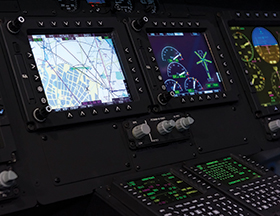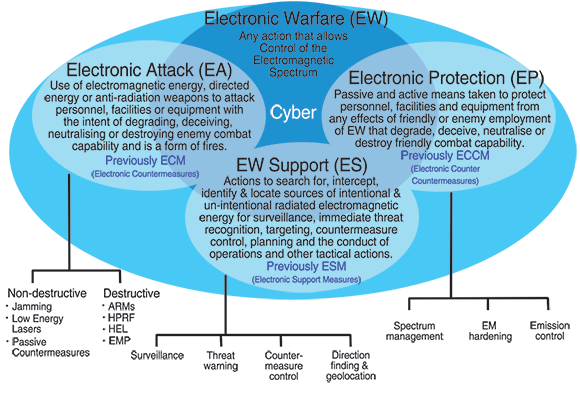

‘Electronic warfare’ tends to be a misunderstood concept – the phrase may conjure up images of cyber warfare waged between countries by hackers sitting behind computers, or even video game war simulations fought in virtual reality.
In truth, in the words of associate professor at the University of Pretoria, Warren du Plessis, electronic warfare (EW) “deals with the exploitation of the electromagnetic spectrum (EMS) to the maximum benefit of oneself and one’s allies and to the maximum detriment of one’s adversaries. The electromagnetic spectrum includes radio waves, infrared radiation and optical systems. This does not mean that such systems are subordinate to EW, but rather that EW considerations are relevant to all systems which use the EMS. For example, nowadays a radar system which is unable to defend itself against jamming is almost useless because jammers are widely available.”
Within this framework, EW deals with extracting as much information from the EMS, using receivers (e.g. the presence, type and position of transmitters), countering an adversary’s attempts to exploit the EMS (by masking one’s own transmissions, or interfering with an adversary’s transmissions), and protecting friendly systems from other users of the EMS (counteracting jamming and avoiding interference from other systems).
“I think that the term ‘electronic warfare’ arose when radio and radar were the only widely-used electronic systems, but the modern widespread use of electronic devices such as computers and cellular telephones has led to confusion about what is implied by ‘electronic’ in this context,” du Plessis continues.
“The best distinction I have found so far is that EW typically deals with the physics of the EMS, while other related fields do not. For example, cyber warfare deals with networks of systems like computers, and requires extensive knowledge of this man-made environment, but not of the EMS.”
Christo Cloete of the Association of Old Crows (AOC) explains that the exploitation of the electromagnetic spectrum has brought significant changes to the world over the past decades. “The rapid growth of electronic technologies and the fast-growing applications in communications, RF navigation, sensing (including radar) and intelligence led to the increasingly important utilisation and reliance on the EMS. Similarly, this same revolution played (and plays) a significant role is shaping military organisational structures worldwide and will play an increasingly greater role in future conflicts,” he states.

Cloete goes on to break down EW into three primary disciplines, which are illustrated in Figure 1. They are:
1. Electronic Support (ES) – gathering knowledge of EMS users with the emphasis on the adversary’s electronic capability in the EMS.
2. Electronic Attack (EA) – degrading, neutralising or destroying adversary electronic capability in the EMS.
3. Electronic Protection (EP) – preserving friendly electronic capability in the EMS through protection from intentional and unintentional interferences.
“Due to the increasingly reconfigurable (software defined) nature of electronic systems as well as their interconnectivity via the EMS, the effect of, and understanding of, the cyber world is becoming increasingly important. EW remains a cat and mouse game – for every new emission (waveform), there is a better ES system; for every EA technique, there is an EP mechanism; for every EP measure, there are better EA systems,” Cloete says.
Aardvarks and Old Crows
Both du Plessis and Cloete are board members of the non-profit Aardvark Roost, the local chapter of the Association of Old Crows (AOC) – an organisation for individuals who have common interests in electronic warfare, electromagnetic spectrum management operations (EMSO), cyber electromagnetic activities (CEMA), information operations (IO), and other information-related capabilities.
The association provides a means of connecting members and organisations nationally and internationally across government, defence, industry and academia to promote the exchange of ideas and information, and provides a platform to recognise advances and contributions in these fields.
The AOC was established in 1964 in Washington DC, USA, and has more than 14 500 members in 47 countries with 70 chapters in 20 countries. The Aardvark Roost was established in the early 1990s, and its members are a mixture of South African National Defence Force (SANDF), Department of Defence (DoD), research institutions, academia and local defence industries.
Weapons in the EW arsenal
Because EW is all about the control of the EMS, every piece of equipment that interfaces to, or makes use of the EMS, can either be exploited or interfere with other EMS users/equipment – whether it is intentional or unintentional. EW equipment can be space-borne, airborne, on or below the surface; static or mobile; autonomous or with an operator in the loop; standalone or networked; and on-board or off-board.
“The most critical part is to have proper situational awareness (SA) to establish the electronic order of battle (EOB) and the user’s intent,” Cloete elaborates. “Therefore, the various receivers and electro-optical sensors are the mainstay of EW. Without detection, classification, identification and geolocation, not only does one not have situational awareness, but you cannot effectively protect yourself or attack your adversaries.”
The types of equipment that enable these functions are typically the radar warning receivers (RWR) onboard military aircraft, various other radar and communication intercept and direction-finding (DF) receivers, visual, infrared (IR) and ultraviolet (UV) sensors.
Cloete continues: “Two approaches exist on the electronic attack front: soft-kill (temporary effects) which entail denial and deception jamming, or hard-kill, which consists of high energy weapons such as high-energy lasers, high-power radio frequency or electromagnetic pulse, or anti-radiation weapons – all of which will physically destroy the target. In addition, there are lower-energy, non-lethal weapons that are used against personnel (examples being low energy lasers or dazzlers and high-power, high-frequency RF for crowd control).”
On the electronic protection side, it is not so much about separate equipment and systems, but rather a focus on built-in design considerations. Examples are stealth platforms, designed to decrease their detection by electronic support and other sensors like radars, electro-optic and acoustic sensors, through special materials and shaping. Reducing detection by ES systems by reducing transmit power, having ultra-low side-lobe antennas and having agile waveforms (frequency and time hopping) are some of these protection mechanisms.
In du Plessis’s view, far and away the most important weapon in EW is the combination of knowledge and experience. “The EMS is not something most people will encounter directly, and their experience is not widely applicable where they do encounter it. For example, cellular telephones use the EMS, but they work so well because of the billions invested by the cellular companies rather than because EMS systems generally work well (they don’t!),” he explains.
In terms of dedicated EW systems, du Plessis boils it down to receivers and jammers: “Receivers aim to extract as much information from the EMS as possible, while jammers seek to disrupt an adversary’s use of the EMS,” he says. “However, any system which uses the EMS should include provisions to make its detection by adversary EW receivers as difficult as possible, and approaches to minimise the effect of interference and adversary jamming.”
Real-world significance
“Since the Gulf War in 1991 (and every conflict since), it has been proven that to dominate the EMS is crucial for all military operations. The EMS is the new high-ground,” states Cloete. “The EMS environment is forever becoming more complex, congested and contested (mostly from the commercial communication environment), making it imperative that EW must continually adapt in order to maintain the spectrum advantage.”
He says one of the main driving forces is the rapid development of commercial-off-the-shelf (COTS) electronics which are available to everybody, including adversaries and terrorists. “The militaries are no longer the main developers and custodians of high-tech equipment. The quick adaption of COTS equipment for ill intent by adversaries enables them to have a much quicker ‘time-to-market’ that the traditional military acquisition processes,” he warns.
Du Plessis echoes the sentiment regarding EW’s importance. “It is absolutely essential! As an absolute minimum, the need for mobility means that military forces require communications which use the EMS. However, modern military systems require precision timing, positioning, guidance and other capabilities which are fundamentally dependent on the EMS.
“Any lack of understanding of the implications of using the EMS can be fatal – even in the simplest possible scenario. For example, having an adversary listen in to one’s communications or eliminate one’s ability to communicate is catastrophic, but even having an adversary know where one’s forces are from their radio transmissions is highly undesirable. Worse yet, an adversary can render sizeable portions of a modern military arsenal useless by disrupting position and guidance systems, leaving one defenceless. The only way to prevent this type of disastrous outcome is to be aware of and to understand the implications of exploitation of the EMS – and that is EW,” he states.
South Africa’s battle readiness
Cloete laments that South Africa has lost its prominence in the local military environment after being, in many cases, on the forefront during the border conflict of the 1970s and ‘80s. He cites the main contributing factors as the loss of personnel and the declining defence budget, and emphasis that the agility and complexity of the EMS/EW environment requires continuous education, proper funding and commitment in order to be successful and provide the contribution to military success that is possible.
“Our current EW knowledge in the military is declining and the SANDF equipment, in most cases, is quite outdated,” Cloete says, “hence the drive by the Aardvark Roost, through hosting various conferences and networking opportunities, to at least improve the EW awareness and knowledge of the decision makers, in order to turn around the current downward spiral. Some of the other African countries currently have more modern EW equipment than South Africa.
“Another paradigm shift required is that of joint acquisitions (although this is not unique to South Africa). Traditionally EW programs were always arms-of-service specific, whilst all the operations are joint. This potentially makes for a non-optimised EW capability, especially in the current EMS environment.”
Things are not all doom and gloom, however, as Cloete points to the fact that while many companies’ supply volumes to SANDF declined over time, some have managed to establish themselves on the international market. “Companies like Sysdel supply various EW receiver and radar jamming equipment internationally,” he elaborates. “GEW, now part of the Hensoldt Group, has a huge footprint in the international communications EW market.
“SAAB Grintek Defence (initially Avitronics) is a market leader in RWR, submarine ES systems and other platform self-protection systems. Research institutions like the CSIR, Department of Defense (DoD), Peace, Safety and Security division (DPSS) and the Institute for Maritime Technology (IMT) continue to assist the SANDF and DoD in developing and maintaining the sovereign EW capability through knowledge and support.”
Du Plessis also sees cause for optimism on the academic side: “As an academic trying to teach difficult technical skills to students, it is wonderful to know that there are still opportunities for engineers to work in high-tech companies which are doing world-leading technical work.
“I sometimes feel like too many of our engineers are forced to become managers at companies which either just import technology in a box from overseas or which just use technologies developed overseas. Having been forced down a management path myself a couple of times and seeing how many of my students have had similar experiences, I realise that not everybody wants that for their career – that is not why we studied engineering!”
Never has a truer word been spoken.
For more information contact info@aardvarkaoc.co.za , https://aardvarkaoc.co.za
© Technews Publishing (Pty) Ltd | All Rights Reserved